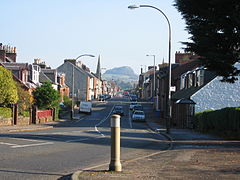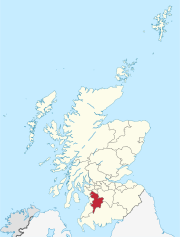|
Darvel
Darvel (Scots: Dairvel,[2] Scottish Gaelic: Darbhail) is a town in East Ayrshire, Scotland. It is at the eastern end of the Irvine Valley and is sometimes referred to as "The Lang Toon" (English: the Long Town). The town's Latin motto, Non sibi sed cunctis, means "Not for ourselves, but for others". HistoryPrehistory and archaeologyArchaeological excavations and surveys, between 2003 and 2007, by Glasgow University Archaeological Research Division (GUARD) in advance of the extension to the Loudoun Hill Quarry, found that people had been living in the area between the Mesolithic and the Late Iron Age periods. In the earliest periods the area was covered by woodlands and those were probably still undisturbed.[3] An additional excavation, in 2007, found a rare late medieval farmstead. The pottery and radiocarbon dates indicate that the farm was occupied in the 14th–15th centuries. It is thought that this site belonged to the farm of Newton, which was first documented in the late 14th century within the parish of Galston. At that time the parish of Galston belonged to the Lockhart family.[4] Roman settlements have been found at the base of Loudoun Hill on Allanton Plain and visible at one point from the Windy Wizzen.[5] Modern history The modern town of Darvel is said to have been established in the late 18th century. The name Darvel was recorded in old charters as variations of 'Dernvale' or 'Darnevaill' and may derive from an old English word 'derne' which means 'hidden.'[6] Sir William Wallace, the Scottish freedom fighter, has also been associated with the area. 15th century minstrel Blind Harry wrote in his poem The Wallace that Wallace and his men defeated an English force at the hill in 1296 during the Wars of Scottish Independence. Blind Harry also tells of how the English general, Fenwick, who supposedly killed Wallace's father, was killed during the battle. Maps of the area now name a mound to the east of Loudoun Hill as 'Wallace's Grave'. A battle between Robert the Bruce and the English was also fought there on 10 May 1307. The land on which Darvel was built was owned by Earls of Loudoun and it was John Campbell, 4th Earl of Loudoun who began the modern town in 1754 as an income for the estate. By 1780, the population had increased to over 400. Loch Gate or Gait was once a significant loch close to the farm of that name, however it was largely drained for agriculture in the 19th century. Darvel LaceIn 1876 lace making was introduced to the Irvine Valley by Alexander Morton,[7] and mills began to spring up in Darvel and nearby Newmilns. The valley's products were exported throughout the world, with India providing a particularly large market for lace, muslin and madras. Darvel became known as the "Lace Town" and Darvel Lace was known throughout the world. Factories in the town also diversified into other textiles, until the late 1970s, when the industry struggled to compete with textiles manufactured in India, China and other Far East countries. The decline was swift. By the end of the 20th century, almost all the factories had closed. Many stood empty for some years, but almost all have now been demolished to make way for housing estates. The last lace factory in Darvel has now closed. The looms were moved to Newmilns, which is home to the only remaining lace factory in the area. Location Darvel is situated on the A71 road that runs from Irvine on the west coast to Edinburgh on the east. The town is 9 miles (14 km) east of Kilmarnock and is the most easterly of the Irvine Valley Towns, the others being Galston and Newmilns. The town was once linked with Stonehouse (via Strathaven) by the Caledonian Railway. However, the line was closed by the LMS before the Second World War. The former Glasgow and South Western Railway branch line to Kilmarnock survived for much longer and was closed in 1964 as part of the Beeching Axe. Much of the route of both lines is still in existence, although the rails have long since gone and many road bridges have been removed. There was a large viaduct to the east of the town, in the lea of Loudoun Hill, which carried the railway line over the valley. This was demolished in 1986, and only the piers remain. The River Irvine flows along the southern boundary of the town and once powered local mills. ClimateDarvel has an oceanic climate (Köppen: Cfb). There is a Met Office observation site located at Saughall, 2+1⁄2 miles (4 km) to the southeast.
Notable buildings Darvel Town Hall was designed by Thomas Henry Smith and completed in around 1905.[9] Darvel Telephone Museum is run by retired engineer Max Flemmich.[10] Monuments
The Dagon Stone The RCHAMS website lists this unhewn olivine monolith as a 'possible' standing stone, about 1.6 m (5 ft 3 in) tall. It is rather curious and its general size and shape suggest a prehistoric standing stone. It has twelve small connected depressions spread over three of its sides, interpreted by some as simple 'scratch' marks,[11] alternatively these have been said to link the stone to astronomical observations and to the noon-day sun height at mid-summer. This would link the stone to life-giving powers, fertility and prosperity.[12] Woodburn casually dismisses it as a stone of no special significance.[11] In 1821, William Morton, a local blacksmith attached a round sandstone ball to the top of it with an iron bar, the large round stone having been found when locals were digging a curling pond.[13] The date 1821 is cut into the iron and this method of fixing became necessary after person or persons unknown had taken it from the top of the Dagon Stone and dumped it into a pond that lay to the east of Ranoldcoup Road.[14] In 1873 it was proposed to break it up as it was in the way of the traffic on the road however San Mair, a local farmer, obtained permission to take it to one of his fields where it served as a rubbing stone for the cattle, indicating that it had little local significance at the time.[14] Although its original location is uncertain, John Woodburn's A History of Darvel (published 1967) noted that the Dagon Stone has stood in at least four different places in the town since the 19th century. The reason for each relocation is unknown, but the stone has been a fixture within Darvel for at least 200 years. The Dagon Stone was initially recorded in 1752[13] as being located on East Main Street, at the junction with Ranoldcoup Road, where it is shown on 19th century maps. It may have been a fallen standing stone that was re-erected following road improvements at the time. The main road was widened in 1894, so the stone was moved to the 'grounds of Brown's Institute' upon the suggestion of Miss Martha Brown of Lanfine, located at the corner of Ranoldcoup Road and Mair's Road, and adjacent to Morton Park. In 1938 it was re-sited in the small park in Burn Road at the junction with West Main Street, near the spot where the SAS Memorial now stands. Finally, the stone was moved to its current location in Hastings Square in 1961 or 1962.[15] Documentation shows that prior to the 19th century, newlywed couples and their wedding parties marched around it for good luck, accompanied by a fiddler.[16] Wedding processions also used to walk three times sunwise round the Dagon stone on the way to the bride's house.[17] The annual parade or "Prawd", originally held on old New Year's Day, headed by the village band used to walk sunwise round the Dagon stone as a mark of superstitious respect.[17] Dagon is also the name of a Philistine god, who was half-man half-fish. But with a Scottish accent it no doubt derives from something much closer to home (assuming it is not just the romantic invention of a Victorian antiquary); 'dogon' is a Scots term for a worthless person, a villain and this could by association have been one of the sanctuary stones associated with the church.[18] It is reminiscent of the Clackmannan stone or Stone of Mannau in Clackmannanshire. CultureA Gala Day is held every two years. This begins with a parade through the town centre which ends at Morton Park, where the main event takes place. The Darvel Music Festival takes place each year in the town. It has grown into a popular event, and is hosted in venues around the village including Darvel Town Hall.[19] SportA speedway training track was built by local farmers (the Craig Brothers) on a coal bing (colliery spoil heap) near to the town in the early 1980s. A team representing Darvel raced in the Scottish Junior League with fixtures staged at Blantyre, Edinburgh and Berwick. There are two local football teams. Darvel F.C., a junior (semi-professional) team, based at Recreation Park, play in the West of Scotland Football League. Darvel Victoria, the local amateur team, play their games at the Gavin Hamilton Sports Centre. Darvel provided one of the Scottish Cup's biggest upsets on the 23 January 2023 by beating Scottish Premiership club Aberdeen 1–0 in the fourth round. Notable people
See alsoReferences
External links
|
||||||||||||||||||||||||||||||||||||||||||||||||||||||||||||||||||||||||||||||||||||||||||||||||||||||||||||||||||||||||||||||||||||||||||||||||||||||||||||||||||||


